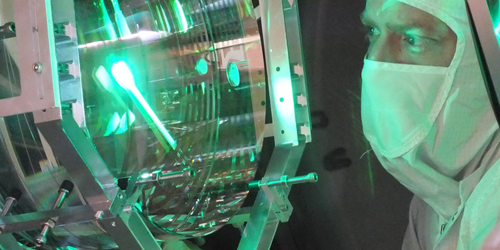Massive Mirrors Feel Fluctuating Photon Forces
To spot gravitational waves, the Virgo and LIGO experiments measure tiny changes in the lengths of their laser interferometer arms—changes as small as one ten-thousandth of a proton diameter. Researchers achieved this sensitivity by reducing “technical” noise—for example, from seismic disturbances and electronics—enough that detector performance is close to the fundamental limits imposed by quantum shot noise (QSN). Now, the Virgo and LIGO collaborations have independently observed a second, fainter source of noise that comes from the lasers’ radiation pressure on the interferometer mirrors [1, 2]. As technical noise is reduced even further, managing this quantum radiation-pressure noise (QRPN) will become increasingly important.
QSN and QRPN both reflect the small-scale “bunchiness” of the beams of light that propagate in an interferometer. QSN is well known to the operators of gravitational-wave detectors. QRPN, in contrast, had gone unobserved because of its minuscule effect on the positions of the interferometers’ 40-kg mirrors.
LIGO and Virgo revealed the signature of QRPN by injecting “squeezed vacuum states” of light into the interferometer beams. Squeezed light is engineered to allow a tradeoff between the certainty of the amplitude and the certainty of the phase of its electric field. Researchers can use this tradeoff to suppress one form of quantum noise while enhancing the other (see Synopsis: Feeling the Squeeze at All Frequencies). In this case, the teams observed that for mirror displacements with frequencies of 30–70 Hz, a certain squeezed-light profile reduced QSN and increased QRPN enough to make the latter effect detectable.
The LIGO Collaboration then went one step further. When QSN and QRPN are independent, together they form the standard quantum limit (SQL) to measurement precision. The interferometer configuration used by LIGO, however, partially correlated these noises, allowing the collaboration to reduce the overall quantum noise at 40 Hz to below the SQL. By tuning the squeezing profile, both collaborations expect to achieve this improvement across a large frequency range.
–Marric Stephens
Marric Stephens is a Corresponding Editor for Physics Magazine based in Bristol, UK.
References
- F. Acernese et al., “Quantum backaction on kg-scale mirrors: Observation of radiation pressure noise in the Advanced Virgo detector,” Phys. Rev. Lett. 125, 131101 (2020).
- H. Yu et al., “Quantum correlations between light and the kilogram-mass mirrors of LIGO,” Nature 583, 43 (2020).




